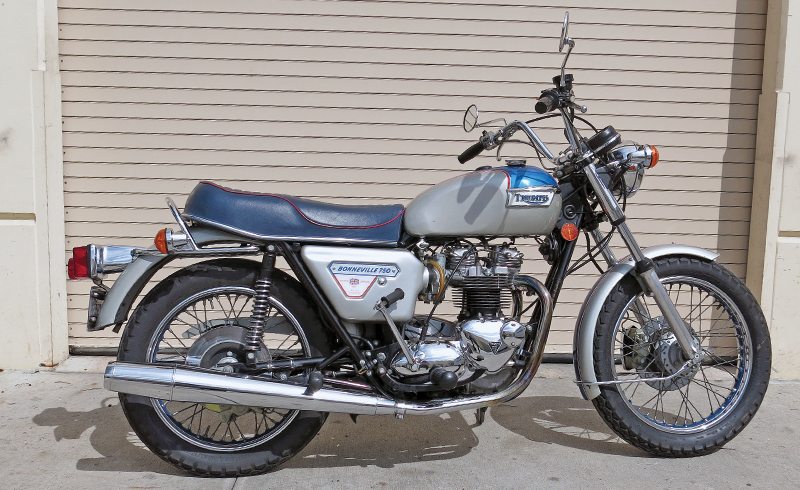
This 750 Bonneville had a pretty good run—under three entirely different managements. First was the traditional factory at Meriden, followed by the workers’ strike and the setting up of a genuine worker-owned cooperative, and finally the Les Harris Bonnies. It was, with constant upgrades over the years, the same bike, same frame, same engine, same name on the tank, and it remained the essential T140.
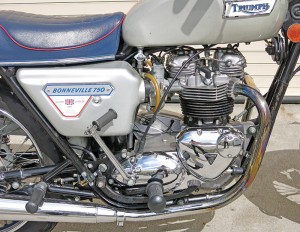
Which was something of a misnomer, since that 140 should have been—in Meriden speak—the bike’s top speed, from the T70 Tiger 250cc single of 1936 to the T120 Bonneville 650 of 1960. However, 140 mph was somewhat of a reach, considering that the bored-out 750 was a bit slower than the 650, albeit torquier.
But no never mind. In truth, by 1973 the Bonnevilles had seen their day as “the fastest motorcycles made anywhere in the world today”… reading from a Triumph ad in 1960. Triumph’s own 750 Trident was faster, not to mention Honda’s CB750 and Kawasaki’s 900cc Z1.
Still, the American importers wanted a 750 version of the vertical twin, both to compete in Class C racing as well as to appeal to the bigger-is-better crowd. The original thought was to build an all-new, bigger engine, but the bean counters said there were not enough beans for that. Meriden would have to use the 650’s bottom end and simply bore out the cylinders. Which could only be bored out so far, as 76mm was the absolute limit, and it did not allow for any overbores. To calm the worry-warts, the first T140s that appeared in September of 1972 were only 724cc, as the cylinders were 75 x 82mm. In December, the full 76mm bore was accepted, realizing 744cc.
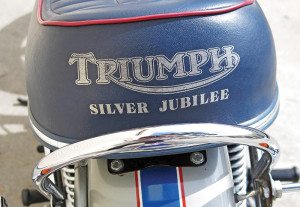
Since the crankshaft wasn’t quite strong enough to cope with these extra cubic centimeters, the engine’s tune was softened with milder, touring-type camshafts and slightly lower compression; output was claimed to be 52 horses at 6,200 rpm, but that was certainly not at the rear wheel. A triplex primary chain ran to the clutch, which now had 30-percent stronger springs. The full-cradle, oil-in-frame design, initiated in 1971, had been more or less sorted out, although many riders said the handling wasn’t as sporty as the previous chassis. All the T140s had 5-speed transmissions, which had been an option on the T120 models, and traditionally British right side shifting. New Girling shocks and a new front fork improved the ride quality on the T140, and a long-overdue disc brake appeared on the front wheel. Tires were Dunlop K70s, a 4.00 x 18 on the rear wheel, a 3.25 x 19 on the front.
Back to politics and economics, a deadly pairing if there ever was one. The British motorcycle industry had begun its unfortunate collapse in the mid-1960s, and by the early ’70s there were just two major components, the Triumph/BSA group, and the Norton/Villiers collection. In 1973, Norton/Villiers absorbed Triumph/BSA, and Dennis Poore, the man now in charge, decided that the Triumph factory should drop the triples and focus on the Bonnevilles. Then Poore said he wanted to close down the Meriden factory and move Bonneville production to the older BSA works. The Meriden workers, fearing the worst, went on strike.
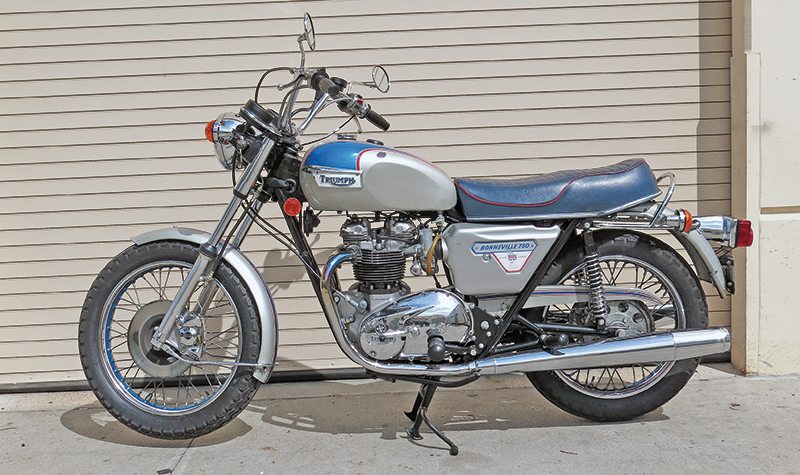
A year and a half later, the Meriden workers cooperative resumed the manufacture of Bonnevilles. These 1976 models had two noticeable changes. First was the left-side gearshift, which had been mandated by the U.S.—and since the U.S. was still the biggest market for these Bonnies, best to comply. Second was the rear disc brake.
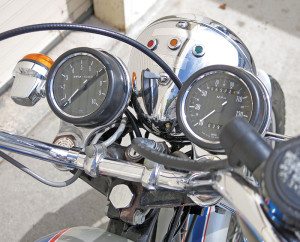
In 1977, the co-op came out with the Silver Jubilee model (in the pictures), the glitzy T140J that honored Queen Elizabeth II’s 25 years on the throne. The paint was—surprise!—silver, with red, white and blue striping. And it had a lot more shine, with chrome timing, transmission and primary cases and specially painted wheels. The side panels had commemorative badges that were altered during the limited production run. The first said “One of a Thousand,” but when the factory realized that it could sell more than that, it was changed to “Limited Edition.”
For 1978, the T140E had American-mandated environmental equipment, such as new Amal Mark II carbs and revised engine breathing by virtue of a new cylinder head…which allowed the carbs to be parallel to each other rather than splayed. For ’79, the factory offered the T140D Special, a mildly customized version intended for the U.S. market, with seven-spoke mag wheels, a 2.5-gallon tank and 2-into-1 exhaust. Electronic ignition became the norm.
In 1980, the Bonnie got a belated electric starter as an option, with the kickstarter sensibly retained. In 1981 came the very Limited Edition Royal Wedding model, to celebrate the wedding of Prince Charles and Lady Diana, of which only 250 were made. The British version of the matrimonial machine had mag wheels and dual front discs, while the more traditional American version sported wire wheels and a single front disc. More foreign-made pieces were seen on the latest T140s, such as German Bing carburetors and Italian Marzocchi shock absorbers. The purists objected.
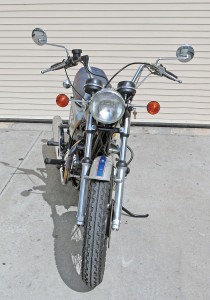
In the early ’80s a recession took place, and the American motorcycle market, the main buyer of Bonnevilles, more or less collapsed. As a result, the co-op soon faced bankruptcy. A wealthy contractor named John Bloor bought the name and marketing rights in 1983, and two years later leased out permission to produce the basic T140 Bonneville to one Les Harris, an old hand in the British industry. Harris built about 1,400 bikes from ’85 to ’88, a few of which got to the U.S.; then his contract with Bloor was over.
In 1989, Bloor began work on a factory to build his own Triumph-labeled models, with a much-modernized Bonneville appearing in 2001.
(This Retrospective article was published in the July 2014 issue of Rider magazine.)








I am currently rebuilding a triumph 750 Bonneville silver jubilee.
1977, with mechanical fuel injection, & yea, it’s the only one that I know of, because in reasurchising it, I found that it must have been, an in production ? Test model, as the injection outlets, in the carburator, are of brittish standard thread.
I’m boath surprised 😮 & stunned by this, as I have not spotted any others like it.
& am proud to be the 1 that the owner chose to rebuild, as this bike only has 6300 miles orignal, & I am now in the possession of restoring the clutch & kick pinion, that was damaged quite awhile back, I suppose.
I feel, that, with these ? Things, left to us, by our forebearrers, we should hold a responsibility, to those who inspire us.
I’m native American & German.
But always agree 👍, God save the queen.
It dosent matter where ur from.
Just that you love what your doing.
Honda harry.